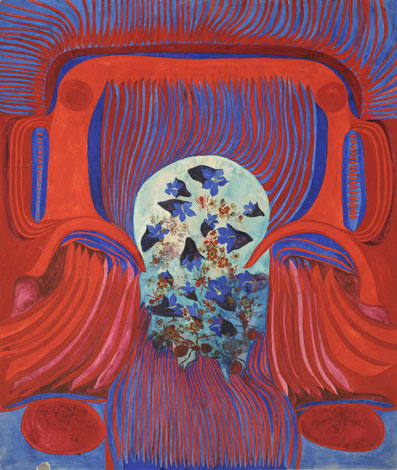This autumn, Haus Galerii has been inspired by Sirje Runge and her time and brought two mysterious, hippie nostalgic decades, the 60s and 70s, onto the gallery walls. The works of female artists, who began at that time and have created the art scenery until today, influenced, illustrated, and decorated it, are exhibited from the time when “Venus was young”, blossoming, bearing fruit. This process of blossoming has been gathered on the gallery walls just like a lush harvest from the mythical and mystic garden of Eden, which between its enticing and fabulous lushness hides an invitation to play, feminine charm that should not be resisted.
The beautiful crown of the exhibition is undoubtedly a bow to Malle Leis. Two metaphysical and charming compositions mark deep appreciation for her feminine, both graceful and powerful at once, style. Soft abstraction is covered by flowers, flowers, flowers, as of yet still quiet, but in her later works powerful and overwhelming everything. I remember the days when we took these works out of the old folders with Malle, lifted them to the light of the windows and Malle said that there is not much left from that time. Now Malle is no longer with us, but the flowers still bloom on these few paintings.
Malle’s flowing and wild blossoms are harmonised by Aili Vint and her op art as a distinct phenomenon then and now: a colour scheme that captures the eye and carries the viewer into tunnels of some other life, into a deep inner world, the corridors of which are colours and Aili’s erotics, her one of a kind graphics technique, as personal as each composition on its own. And this is followed by Mare Vint who now draws on canvas, whose colour pencil is soft and whose graphite is never grey. Mare’s grey worlds are like Sirje Runge’s white canvases where the point of the almost colourless visual is the colour of emotion, feeling, created by one simple moment, a pool in the grass, a lantern on the street or a poetically architectural silhouette in a timeless city.
The so-called cover girl of this exhibition is a powerful, yet so gentle and fragile portrait of a young lady by Mari Roosvalt. Mari and her painting, later personalised collages, love for photo and film, magic of colours, accompanied by compositions inkling from this, has given her a clearly distinguishable style from the beginning. Particular places depicted by the artist also create different associations for everyone, the author’s clear vision of the surrounding experience does not tie you up at all. The early abstractions of Tiiu Pallo-Vaik are as powerful as the others and almost on fire, as if the magnifications of biomorph interior worlds, which represent a fiery foreplay for her later cute watercolours and laconic collages, where paper underlines paper.
And there is something so innocently sincere, healthily genuine and girlish here, in Evi Tihemets’ pink castle, which hides an entire story. The narrative runs through each one of her graphic sheets, even through “Contemplation” where a long-haired person sits in the corner with elegant carelessness, Venus who has grown up and stepped from the 60s to the 70s, together with everyone, but still on her own. The story continues on a more abstract route already with Vive Tolli and her romantic nationalism, which is only Vive and no one else. “Sea Cows” on the gallery wall, the author’s sample, has become an ornament in its own right, a mark on the more powerful pages of Estonian graphics. The “Departing Lake” refers to poetics already in the title. Even without seeing the picture, this combination of words grabs your finger and does not let go.
The women’s art of Estonia is very rich, versatile, and the list of names could go on and on. Is this exhibition at Haus Galerii a chance or something arbitrary? To be honest, there are not many works from these decades. The attitudes were different back then, works were given as presents, it was the life and creation of young authors who did not have a visible ending to think about collecting works in their closets. Many of the works were sent somewhere into the depths of the Soviet Union and life went on. Art and money did not go together, creation referred to Bohemianism, it was great to be with yourself and similar people. Everyone was different in their own way, but then again similar. Searching for yourself under pressure is interesting in any world of art. A hidden message between the lines of the visual, which seems to ooze out peace when a blue lake exits the picture, or a circle, square, and triangle that do not look suspicious, but still include an intrigue only the people in the know notice. The dialogue of the exhibition “Old Venus. Young Venus” carries its time and memories, but also a message of the contribution of an intellectual and creative woman to the society as a whole. It is a great privilege to be part of this slight smirk that began in the 60s and is now among us in a consistent, tactful, knowledgeable, and fruitful form. It is a privilege to understand and see. You can use this privilege at Haus Galerii until September 23 until the exhibition “Old Venus. Young Venus” is still open.
Piia Ausman, Head of Haus Gallery
Haus Gallery has cooperated with the new Web magazine Edasi (in English Forward) (Edasi.org). In the weekly column we talk about something interesting and noteworthy in the field of art to Estonian readers. The Forward way of thinking, positive world view, intelligent journey with the reader through meaningful moments, slow journalism, which offers counterpoise to the racy information barrage, which invites to stop, feel and think along just as art inspires Haus Gallery to write stories for Forward.
.png)
